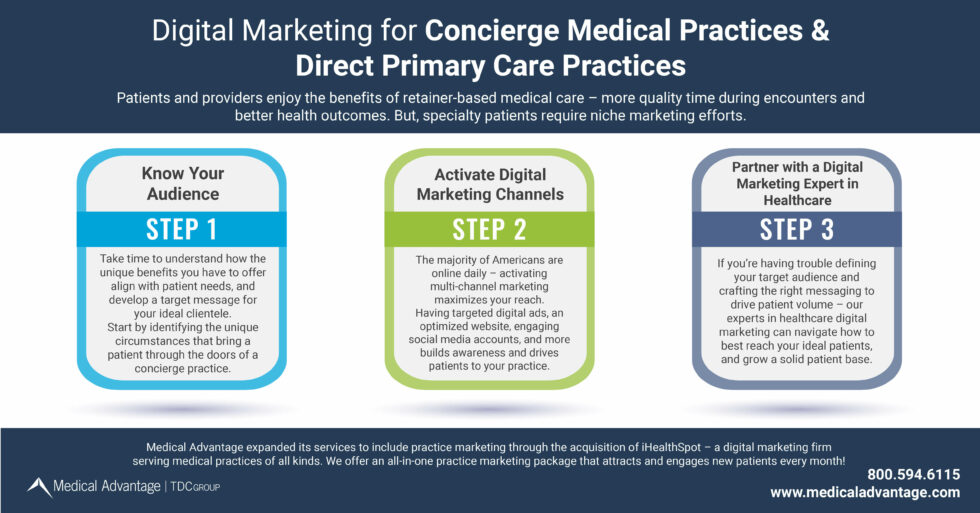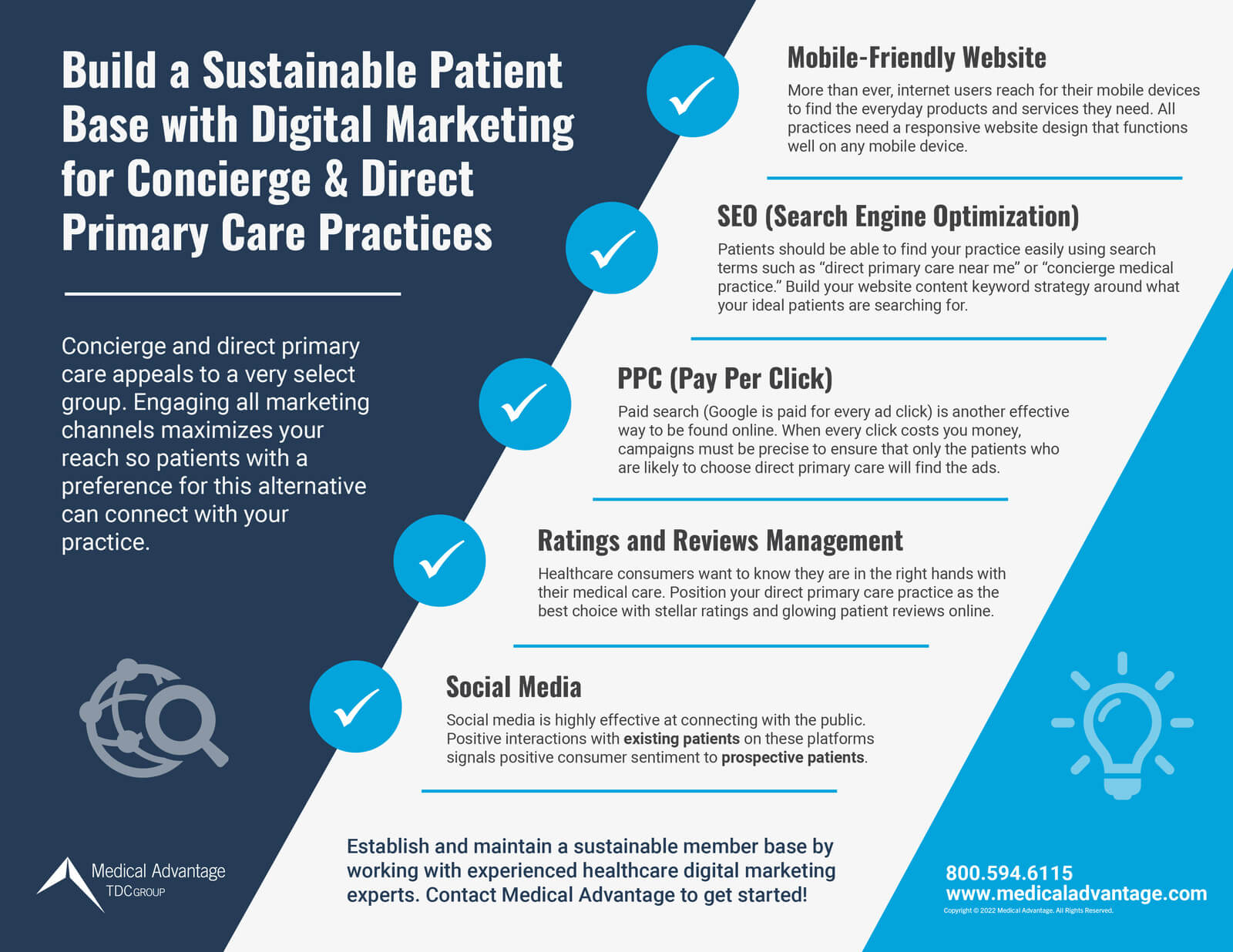Concierge medical practices are an alternative healthcare model with a unique ability to offer more time and focus on patients. With this retainer-based structure, providers serve a smaller patient base allowing clinicians to provide more generous allocations in their daily schedules.
With more focus on each patient, providers see better outcomes as they deliver more personalized medicine, patient-centered medicine, and timely preventive care. This type of arrangement is known by other names such as premier practice, platinum practice, direct pay, direct primary care, membership medicine, or boutique medical practice.
Because this healthcare model is not mainstream, many patients may not even be aware that this membership-based care is an option. Marketing for concierge medical practices empowers independent clinicians to reach patients who would most benefit from alternative healthcare.
What Is Concierge Medicine?
Concierge medicine is entrepreneurial in essence, as doctors build a patient base secured by direct subscribers rather than insurance payers. Formally defined, concierge medicine is a retainer-based, doctor-patient relationship in which a fee or retainer is paid annually. However, with some direct primary care providers, subscribing patients pay monthly.
While the reasons a provider or a patient would want such an arrangement vary by individual preference, one of the common reasons for “membership medicine” is a desire to have more consultation time.
Physicians want to spend more time with each patient, but traditional healthcare has its limitations, sometimes leaving both patients and providers feeling rushed. Survey results reveal that the vast majority of concierge care physicians have more career satisfaction and higher-quality relationships with patients.

Motivations of the Concierge Medicine Patient
Humans are creatures of habit who tend to only make a change when there is enough motivation or agitation present. To understand how to reach those who would enroll in retainer or subscription-based care services, we need to consider what circumstances would steer them toward alternatives.
Examples of Patients Who Seek Alternative Care
Below are just a few anecdotal examples of patients who may be inclined to enroll with direct care membership programs. Prospects to target will vary by market territory.
- Self-employed – When you have no employer-funded insurance, premiums for insurance are usually cost-prohibitive. Monthly primary care subscription models help the self-employed have a doctor to call on, plus predictable upfront costs (versus waiting until care is immediately needed and calling around for loose estimates for self-pay).
- Self-pay with chronic conditions – Those in good health can get by with rare self-pay visits, but those who have chronic health problems often require frequent visits that add up quickly. Direct primary care can be the more affordable option for those who need regular follow-up visits.
- Patients with complex challenges – As mentioned earlier, one of the main drivers of the direct-pay model is how the insurance-based model often does not allow enough time during office visits. Those who need more time to address all of their concerns benefit from seeing a doctor who has complete control over his or her schedule.
- More money than time – Those with the financial means are willing to pay for on-demand care, meaning that they can contact the doctor any time for personal care. Busy executives with tight schedules would benefit from care with minimal wait time. Also, some affluent people wanting as much privacy as possible may find this with having a personal physician on retainer.
- Medicare patients – Sometimes Medicare patients have a hard time finding healthcare that meets their needs. While Medicare is not likely to cover direct primary care costs, flat-fee care is a viable alternative to ensure that they get the medical services they need.
A set of circumstances very different from the typical patient is what brings these patients to the door of concierge or direct primary care, and thus these people ought to be approached differently. Marketing for concierge medical practices leverages strategies designed with these distinctions in mind to better resonate with prospects.
Concierge Medicine Practice Marketing: Tools for Practice Growth
Traditionally, insurance companies have been the driving force that brings doctors and patients together. So, when the influence of insurance companies is removed from the care equation, other means must be found to build a patient base. Concierge medicine marketing plays a powerful role in influencing patients to switch to this healthcare alternative. Digital marketing for doctors as part of your outreach strategy helps you tap this niche market.
Search Engine Optimization for Medical Practices
SEO (or search engine optimization) refers to efforts made to be found on Google at the moment prospects are looking. There are different kinds of searches and ideally, your concierge practice should be found for all of them.
- Branded – The user has already heard of the establishment and searches for it by name.
- Transactional – The user needs the services soon and the search terms they use bring up matches for providers. Usually, this returns localized results, including Google My Business listings.
- Informational – The user has a problem and wants to learn more about what they can do about it. These questions are answered by website content, such as a blog.
With keyword strategy, you need to get into your prospect’s head. For example, a patient might Google “self pay doctors near me.” This keyword has a monthly search volume of 630 meaning over 600 people google this term each month. Such a patient is probably needing care very soon, so it is to your advantage when your practice appears in this search. Ensuring that your website contains these relevant terms fuels your medical practice SEO.
Paid Search Advertising in Healthcare
While SEO is referred to as organic search (unpaid), PPC (pay-per-click) or Google Ads are forms of paid search. This means that businesses pay for placement in search results. With Google Ads for medical practices, you only pay if someone clicks your “ad”. Paid results look very similar to organic results on the search (but are labeled as “Ad”) and are usually placed near the top of the list.
Paid search tends to deliver gains faster, but placements are lost as soon as the campaigns are turned off. Compare this with organic search, which takes time to build up, but the visibility power is for keeps. Having both organic and paid search working in tandem maximizes online visibility.
Reputation Management: Capitalize on Good Reviews
A medical practice’s online reputation matters now more than ever. A Doctor.com survey found that 88% of healthcare consumers read online reviews to vet referrals. What this tells us is that today’s patient is willing to do the extra work to ensure that they make the most informed decision. This same survey also found that most patients will not consider a practice with a rating below four stars. Online reputation management for doctors is crucial when marketing for concierge medical practices.
Because concierge and direct primary care providers are designed to give more time and attention to patients, this fosters patient loyalty and a better doctor-patient relationship. Ideally, these positive experiences should be shared online, so that when prospects do find your practice online, the ratings and reviews nurture consumer confidence.
Increase Patient Engagement with Social Media
Patients do not see their doctors every day, but many of them use social media daily. Social media for doctors allows practices to stay connected with patients and the community year-round with important announcements, timely information, and content that builds rapport.
Survey results reveal that 60% of patients trust their doctor’s posts over other sources on social media. Social media gives providers a platform to dispel myths and mitigate the impact of misinformation on medical topics, and this positions your practice as an authority.
It takes time to build a social media following, but once you have an engaged audience, patient loyalty is strengthened, and your practice brand is fortified. Non-patients that come upon your posts are likely to view high engagement as a positive endorsement of your service quality.

Using These Tools to Develop a Healthcare Marketing Strategy
Compared to conventional medical practices, concierge and direct primary care face a greater challenge to reach prospects. When done with precision, digital marketing is more effective at targeting a specific audience compared to traditional advertising.
Think of your healthcare digital marketing strategy as a ship at sea. The more nets you have cast, the greater your chances are of catching the desired fish. So, having all channels activated – organic search, paid search, online reputation management, and social media – gives marketing for concierge medical practices the best chance for success.
How Medical Advantage Acts as Your Medical Marketing Agency
Over 4000 providers rely on our practice marketing services to connect with the right patients for their practices. Our team of medical marketing experts has first-hand experience with concierge healthcare.
For a startup concierge practice, our independent doctor marketing strategies produced a 268% increase in website traffic, a 341% increase in page one keyword rankings, and a 400% increase in web-generated new patient requests.
Reaching prospective patients who would want concierge or direct primary care can be daunting, but our experienced digital marketing team knows how to best target your niche using fine-tuned precision with concierge medical practice marketing.
Get started today by requesting a free, no-obligation call with one of our concierge medical practice consultants! Fill out the form below and someone will be in touch soon.



